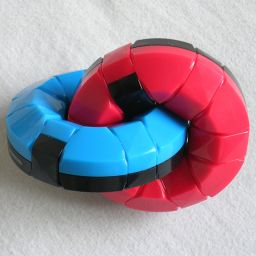


Dual Circle consists of two tightly linked rings. Each ring has six sections. If a ring is rotated about its axis, the section on the other ring that is located in the hole of the first ring will be rotated too. The rings are coloured so that the orientation of the 12 sections is visible.
This puzzle is produced by Hanayama, and was invented by Bram Cohen and Oskar van Deventer. Bram came up with the idea of how the pieces move and affect each other, but had them arranged in two parallel rows. He called that puzzle Rotabram. Oskar came up with the design using two linked rings.
If your browser supports JavaScript, then you can play Dual Circle by clicking the link below:
There are 12 rotating ring sections, each with 6 possible orientations. This gives a maximum of 612 positions. There is however a twist 'parity' restriction, so only 611 = 362,797,056 positions are possible.
The twist restriction is rather complicated, and not at all obvious. Click the link below for a full explanation.
I have calculated God's Algorithm for this puzzle. It turns out that it can be solved in at most 17 turns (12.992 on average), or 36 moves (20.678 on average) if every sixth of a rotation counts as a move.
| Ring Turns | Sixth Turns | ||||||||||||||||||||||||||||||||||||||||||||||||||||||||||||||||||||||||||||||||||||||||||||||||||||||||||||||||||||||||||
|---|---|---|---|---|---|---|---|---|---|---|---|---|---|---|---|---|---|---|---|---|---|---|---|---|---|---|---|---|---|---|---|---|---|---|---|---|---|---|---|---|---|---|---|---|---|---|---|---|---|---|---|---|---|---|---|---|---|---|---|---|---|---|---|---|---|---|---|---|---|---|---|---|---|---|---|---|---|---|---|---|---|---|---|---|---|---|---|---|---|---|---|---|---|---|---|---|---|---|---|---|---|---|---|---|---|---|---|---|---|---|---|---|---|---|---|---|---|---|---|---|---|---|---|
|
|
| |||||||||||||||||||||||||||||||||||||||||||||||||||||||||||||||||||||||||||||||||||||||||||||||||||||||||||||||||||||||||
The single antipodal position at 36 sixth turns is the position with all pieces twisted 180 degrees.
Phase 1: Solve the red ring sections
Phase 2: Solve the blue ring sections
Phase 2 in the above solution can take quite a number of moves. It may therefore be quite useful to have some further move sequences in your arsenal to speed things up. Below is a complete set of move sequences that only affect one or two pieces in the blue ring. Once you have solved the red ring, you will need to apply no more than four of these sequences to solve the blue ring.
Mentally label the 6 sections of the blue ring with the letters A to F, where A is the one that lies inside the red ring. A letter followed by a + or a - indicates that you have to turn that section one way or the other by one click. Two or three plusses or minuses obviously means it has to move two or three clicks.
| Effect | Move sequence | Effect | Move sequence | Effect | Move sequence | Effect | Move sequence |
|---|---|---|---|---|---|---|---|
| B++, C++ | B-- C++ B-- | B--, C-- | B++ C-- B++ | ||||
| B++, C- | B+ C- B+ | B--, C+ | B- C+ B- | E-, F++ | F+ E- F+ | E+, F-- | F- E+ F- |
| B+++, D+ | B- C- D+ C+ B-- | B+++, D- | B+ C+ D- C- B++ | D+, F+++ | F- E- D+ E+ F-- | D-, F+++ | F+ E+ D- E- F++ |
| B+++, D+++ | B+++ C+++ D+++ C+++ | D+++, F+++ | F+++ E+++ D+++ E+++ | ||||
| B++, E+ | B++ A- F- E+ F+ A+ | B--, E- | B-- A+ F+ E- F- A- | C+, F++ | F++ A- B- C+ B+ A+ | C-, F-- | F-- A+ B+ C- B- A- |
| B++, E-- | B+ E- B+ E- | B--, E++ | B- E+ B- E+ | C--, F++ | F+ C- F+ C- | C++, F-- | F- C+ F- C+ |
| B+, F+ | F+ A- B+ A+ | B-, F- | F- A+ B- A- | ||||
| B++, F++ | F++ A-- B++ A++ | B--, F-- | F-- A++ B-- A-- | ||||
| B+++, F+++ | F+++ A--- B+++ A+++ | ||||||
| C+++ | B+++ C+++ B+++ | E+++ | F+++ E+++ F+++ | ||||
| C+++, D++ | C- D+ C- D+ C- | C+++, D-- | C+ D- C+ D- C+ | D++, E+++ | E- D+ E- D+ E- | D--, E+++ | E+ D- E+ D- E+ |
| C+, E+ | E+ A- C+ A+ | C-, E- | E- A+ C- A- | ||||
| C-, E++ | E+ C- E+ | C+, E-- | E- C+ E- | C++, E- | C+ E- C+ | C--, E+ | C- E+ C- |
| C++, E++ | E-- C++ E-- | C--, E-- | C++ E-- C++ | ||||
| C+++, E+++ | C+++ D+++ E+++ D+++ | ||||||
| D++ | D+ A- D+ A+ | D-- | D- A+ D- A- |